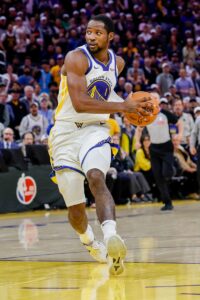Scott Ostler of The San Francisco Chronicle (subscription required) has a prescription for fixing the Warriors that includes trading Jonathan Kuminga and removing Draymond Green from the starting lineup, at least on a temporary basis. He contends that significant changes are required to jump start a team that had lost three straight games coming into tonight and is in peril of slipping out of a play-in spot.
Ostler argues that Kuminga, who will be eligible to be dealt on January 15, has become too much of a distraction because of his up-and-down play and his constantly changing status in coach Steve Kerr’s rotation. Kuminga returned to action Thursday after being held out of the previous three games, but he played just 9:31 and missed four of his five shots from the field. Ostler believes Kuminga still has trade value because there are rival teams who think he hasn’t been given a legitimate chance to succeed and he would be better off if he’s freed from Golden State’s system.
Green should come off the bench for at least a game or two, Ostler adds, due to his persistent turnover issues (3.3 per game this season compared to a career average of 2.3) and his poor shooting (39.1% coming into Saturday’s game). Ostler predicts Green would accept the move and it would allow the team to surround Stephen Curry with at least three other shooters in the starting lineup.
There’s more from the Pacific Division:
- Rookie center Maxime Raynaud will be the Kings‘ starting center “for the foreseeable future” after Friday’s announcement that Domantas Sabonis will miss at least four-to-five more weeks, writes Jason Anderson of The Sacramento Bee (subscription required). The French big man, who was taken with the 42nd pick in this year’s draft, has been productive since moving into the starting lineup, averaging 15.4 points, 8.8 rebounds and 1.4 assists over the past five games while shooting 53.4% from the field and 33.3% from beyond the arc. Coach Doug Christie juggled his starting lineup on Thursday, Anderson adds, moving Keegan Murray from power forward to small forward, which the organization views as his “future” position.
- Lakers coach J.J. Redick said “the hope” is that Rui Hachimura will only be sidelined for three to five days with groin soreness, according to Dave McMenamin of ESPN (Twitter link). Hachimura started to feel discomfort in his hip area during Thursday’s game at Utah. Redick also said Deandre Ayton (left elbow) and Austin Reaves (left calf) are both making progress and could be ready for Tuesday’s contest at Phoenix.
- Clippers coach Tyronn Lue said Derrick Jones Jr., who’s sidelined with an MCL sprain, has begun playing in five-on-five scrimmages, tweets Law Murray of The Athletic. Murray suggests that Jones might be able to beat his projected timetable for a return in early January.
- Suns guard Grayson Allen missed his second straight game tonight with soreness in his right knee, but he’s expected back soon, per Duane Rankin of The Arizona Republic (Twitter link). “No setbacks. He’s doing more and more every day,” coach Jordan Ott said. “It’s going on the right direction. Then we’re hopeful that it continues and he’ll be out there soon.”
 “You definitely want to see how guys respond in practice,” Kerr said. “And I can tell you, JK, has been great this last week as he’s been out of the rotation. He’s working really hard, and I’m going to reward that.”
“You definitely want to see how guys respond in practice,” Kerr said. “And I can tell you, JK, has been great this last week as he’s been out of the rotation. He’s working really hard, and I’m going to reward that.”